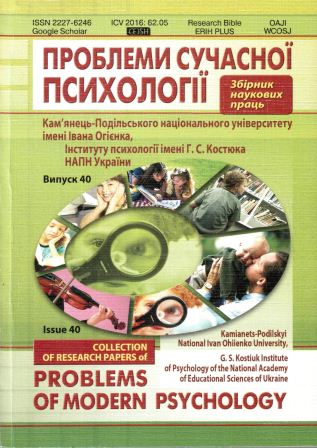Особливості формування етнічної атракції в контексті міжетнічної взаємодії
DOI:
https://doi.org/10.32626/2227-6246.2018-40.343-352Keywords:
міжетнічні комунікації, етнічна атракція, етнічні взаємини, етнічна ідентифікація.Abstract
У статті розглянуто роль і значення етнічної атракції між представниками різних етнічних груп на формування та розвиток міжетнічних взаємин, дослідження таких стосунків у практиці вивчення міжетнічних відносин. Установлено, що об’єктом дослідження багатьох зарубіжних і вітчизняних учених є етнічна атракція, її вплив на формування, становлення та розвиток міжетнічних взаємин, їх психологічний зміст та основні функції. Автором зроблено висновок, що сучасне суспільство потребує додаткових соціально-психологічних досліджень, щоб здійс нити комплексне вивчення чинників формування етнічної атракції, її значення в системі міжетнічних взаємин, тобто питання, які досі не досліджені в цій сфері психології, залишаючи великі можливості для вчених-психологів. Розглянуто особливості формування етнічної атракції між пред-ставниками різних етнічних груп. Автором показано, що структура формування етнічної атракції відображає психологічні аспекти міжетнічної комунікації, пов’язані з різними видами соціальних відносин у суспільстві. Акцентовано увагу на характеристиці етнічної атракції та практичним її дослідженням у галузі наукових знань соціальної психології. Зроблено висновок, що існує необхідність розробки системи раннього прогнозування конфліктних ситуацій і моделі виникнення й поширення етнічних конфліктів, яка сприятиме ефективному запобіганню кризових станів у галузі міжетнічних відносин із небезпечними наслідками.
References
Барт Ф. Этнические группы и социальные границы / Ф. Барт. – М. : Новое издательство, 2006. – 200 с.
Денисова Г. С. Этносоциология / Г. С. Денисова, М. Р. Радовель. – Ростов-на-Дону, 2000. – 256 с.
Слющинський Б. В. Міжкультурна комунікація як феномен сучасної культури / Б. В. Слющинський // Нова парадигма. – 2004. – Вип. 37. – С. 229.
Солдатова Г. У. Психология межэтнической напряженности / Г. У. Солдатова. – М. : Смысл, 1998. – 389 с.
Стефаненко Т. Г. Этнопсихология / Т. Г. Стефаненко. – М. : Институт психологии РАН, 1999. – 320 с.
Giles H. The dynamics of intergroup communication / H. Giles, S. Reid, J. Harwood. – New York : Peter Lang, 2010. – 456 p.
Fitch K. L. Handbook of language and social interaction / K. L. Fitch, R. E. Sanders (eds.). – New Jersey : Erlbaum, 2005. – 389 p.
Hoffman, A. J. Unity through community service activities: Strategies to bridge ethnic and cultural divides / A. J. Hoffman, Parker Espinosa, E. Sanchez, J. Wallach. – Jefferson, NC : McFarland, 2005. – 270 p.
Reid S. A. Social psychological approaches to intergroup communication / Scott A. Reid // The Handbook of Intergroup Communication. – Cambridge, 2012. – P. 249–252.
Tajfel H. Human Groups and Social Categories: Studies in Social Psychology / H. Tajfel. – Cambridge University Press. – 384 p.
Fehr B. Friendship processes / B. Fehr. – Thousand Oaks, CA : Sage, 1995. – 512 p.
Steinhorn L. By the colour of our skin: The illusion of integration and the reality of race / L. Steinhorn, B. Diggs-Brown. – New York, NY : Plume, 2000. – 336 p.
Downloads
Published
How to Cite
Issue
Section
License
Copyright
The Editorial Board has the full right to publish original scientific papers containing results of theoretical and experimental research works which are not currently subject to review for publication in other scientific editions. The Author shall transfer to the editorial board of the Collection the right to spread the electronic version of the paper, as well as the electronic version of the paper translated into English (for papers originally submitted in Ukrainian and Russian) by all kinds of electronic means (placement at the official website of the Collection, electronic databases, repositories etc).
The Author of an article reserves the right to use materials of the paper, without approval with the editorial board and the founders of this Collection: a) partially or fully, for educational purposes; b) for writing own dissertation papers; c) for preparation of abstracts, conference reports and presentations.
The Author of an article can place electronic copies of the paper (including the final electronic version downloaded from the official website of the Collection) at:
- personal web resources of all Authors (websites, webpages, blogs etc.);
- web resources of the institutions where the Authors are employed (including electronic institutional repositories);
- non-profit public access web resources (for example, arXiv.org).
But in all cases, it is obligatory to have a bibliographic reference to the paper, or a hyperlink to its electronic copy placed at the official website of this Collection.






